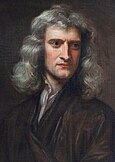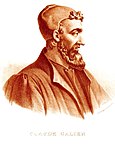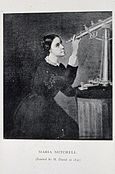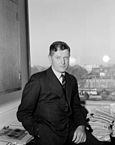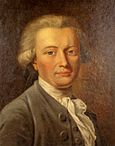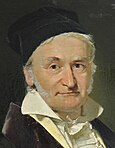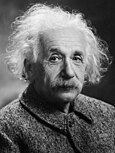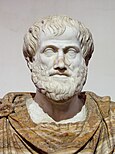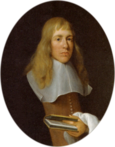User:SightByVision/sandbox/Featured biography
Usage
The layout design for these subpages is at Portal:Science/Featured biography/Layout.
- Add a new Selected biography to the next available subpage.
- Update "max=" to new total for its {{Random portal component}} on the main page.
Selected biographies list
Biographies 1–20
Portal:Science/Featured biography/1
Portal:Science/Featured biography/2
Feynman was a keen and influential popularizer of physics in both his books and lectures. He is famous for his many adventures, detailed in the books
Portal:Science/Featured biography/3
Aristarchus believed the stars to be very far away, and saw this as the reason why there was no visible parallax, that is, an observed movement of the stars relative to each other as the Earth moved around the Sun.
Portal:Science/Featured biography/4
Portal:Science/Featured biography/5 Francis Crick, Francis Harry Compton Crick OM FRS (8 June 1916 – 28 July 2004), was a British molecular biologist, physicist, and neuroscientist, and most noted for being one of the co-discoverers of the structure of the DNA molecule in 1953. He, James D. Watson and Maurice Wilkins were jointly awarded the 1962 Nobel Prize for Physiology or Medicine "for their discoveries concerning the molecular structure of nucleic acids and its significance for information transfer in living material" .[2]
Portal:Science/Featured biography/6
He seldom published papers, preferring lengthy correspondences with colleagues (such as Bohr and Heisenberg, with whom he had close friendships.) Many of his ideas and results were never published and appeared only in his letters, which were often copied and circulated by their recipients. Pauli was apparently unconcerned that much of his work thus went uncredited.
Portal:Science/Featured biography/7
However, much of Galen's understanding is flawed from the modern point of view. For example, he did not recognize
Portal:Science/Featured biography/8
Portal:Science/Featured biography/9
Portal:Science/Featured biography/10
Portal:Science/Featured biography/11
Her parents were
Using a telescope, she discovered "Miss Mitchell's Comet" (Comet 1847 VI, modern designation is C/1847 T1) in the autumn of 1847. Some years previously, King Frederick VI of Denmark had established gold medal prizes to each discoverer of a "telescopic comet" (too faint to be seen with the naked eye). The prize was to be awarded to the "first discoverer" of each such comet (note that comets are often independently discovered by more than one person). She duly won one of these prizes, and this gave her worldwide fame, since the only previous woman to discover a comet had been Caroline Herschel.
Portal:Science/Featured biography/12
Dr. Kaku is the author of several scholarly, Ph.D.-level textbooks and has had more than 70 articles published in physics journals covering topics such as superstring theory, supergravity, supersymmetry, and hadronic physics. He is also known as an author of popular science books, including the best-sellers Beyond Einstein, Visions, Hyperspace, and Parallel Worlds, and the host of several radio shows, as well as being a popular figure in science television shows due to his accessible approach to the layman on explaining complex physics.
Portal:Science/Featured biography/13
Portal:Science/Featured biography/14 Gregor Mendel (1822–1884) was an
It was not until the early 20th century that the importance of his ideas were realized. In 1900, his work was rediscovered by Hugo de Vries, Carl Correns, and Erich von Tschermak. His results were quickly replicated, and genetic linkage quickly worked out. Biologists flocked to the theory, while it was not yet applicable to many phenomena, it sought to give a genotypic understanding of heredity which they felt was lacking in previous studies of heredity, which focused on phenotypic approaches.
Portal:Science/Featured biography/15
Sir
From the mid-1950s, he worked extensively in immunology and was a major contributor to the theory of
Portal:Science/Featured biography/16
Johann Georg Adam Forster (November 27, 1754 – January 10, 1794) was a German naturalist, ethnologist, travel writer, journalist, and revolutionary. At an early age, he accompanied his father on several scientific expeditions, including James Cook's second voyage to the Pacific. His report from that journey, A Voyage Round the World, contributed significantly to the ethnology of the people of Polynesia. As a result of the report Forster was admitted to the Royal Society at the early age of twenty-two and came to be considered one of the founders of modern scientific travel literature.
After his return to continental Europe, Forster turned towards academics. From 1778 to 1784 he taught natural history. Most of his scientific work consisted of essays on botany and ethnology, but he also prefaced and translated many books about travels and explorations, including a German translation of Cook's diaries. Forster was a central figure of the Enlightenment in Germany.
Portal:Science/Featured biography/17
Portal:Science/Featured biography/18
Carl Friedrich Gauss ⓘ (30 April 1777 – 23 February 1855) was a German mathematician and scientist of profound genius who contributed significantly to many fields, including number theory, analysis, differential geometry, geodesy, magnetism, astronomy and optics. Sometimes known as "the prince of mathematicians" and "greatest mathematician since antiquity", Gauss had a remarkable influence in many fields of mathematics and science and is ranked as one of history's most influential mathematicians.
Gauss completed
Portal:Science/Featured biography/19
Portal:Science/Featured biography/20
Biographies 21–40
Portal:Science/Featured biography/21
Among his many investigations were:
Portal:Science/Featured biography/22
Leonardo has often been described as the archetype of the "Renaissance man", a man whose seemingly infinite curiosity was equalled only by his powers of invention.[1] He is widely considered to be one of the greatest painters of all time and perhaps the most diversely talented person ever to have lived.[2]
It is primarily as a painter that Leonardo was and is renowned. Two of his works, the
Portal:Science/Featured biography/23
Portal:Science/Featured biography/24
Otto Hahn, (8 March 1879 – 28 July 1968) was a German chemist and Nobel laureate, a pioneer in the fields of radioactivity and radiochemistry. He is regarded as "the father of nuclear chemistry".
Hahn was a courageous opposer of Jewish persecution by the Nazi Party and after World War II he became a passionate campaigner against the use of nuclear energy as a weapon. He served as the last President of the Kaiser Wilhelm Society (KWG) in 1946 and as the founding President of the Max Planck Society (MPG) from 1948 to 1960. Considered by many to be a model for scholarly excellence and personal integrity, he became one of the most influential and revered citizens of the Federal Republic of Germany.
Portal:Science/Featured biography/25
Portal:Science/Featured biography/26
Aspiring to become the next
Portal:Science/Featured biography/27
Priestley is credited with his independent discovery of oxygen by the thermal decomposition of mercuric oxide, having isolated it in 1774. During his lifetime, Priestley's considerable scientific reputation rested on his invention of carbonated water, his writings on electricity, and his discovery of several "airs" (gases), the most famous being what Priestley dubbed "dephlogisticated air" (oxygen). Priestley's determination to defend phlogiston theory and to reject what would become the chemical revolution eventually left him isolated within the scientific community.
Portal:Science/Featured biography/28
Barry Voight (/vɔɪt/; born 1937) is an American geologist, volcanologist, author, and engineer. After earning his Ph.D. at Columbia University, Voight worked as a professor of geology at several universities, including Pennsylvania State University, where he taught from 1964 until his retirement in 2005. He remains an emeritus professor there and still conducts research, focusing on rock mechanics, plate tectonics, disaster prevention, and geotechnical engineering.
In April 1980, Voight's publications on landslides, avalanches, and other mass movements attracted the attention of Rocky Crandell of the United States Geological Survey (USGS), who asked him to look at a growing bulge on the Mount St. Helens volcano in the state of Washington. Voight foresaw the collapse of the mountain's north flank as well as a powerful eruption. His predictions came true when St. Helens erupted in May 1980; Voight was then hired by the USGS to investigate the debris avalanche that initiated the eruption. After his work at Mount St. Helens brought him international recognition, Voight continued researching and guiding monitoring efforts at several active volcanoes throughout his career, including Nevado del Ruiz in Colombia, Mount Merapi in Indonesia, and Soufrière Hills, a volcano on the Caribbean island of Montserrat. For his research, publications, and disaster prevention work as a volcanologist and engineer, Voight has been honored with numerous awards, appointments, and medals.
Portal:Science/Featured biography/29
Hilary Whitehall Putnam (/ˈpʌtnəm/; July 31, 1926 – March 13, 2016) was an American philosopher, mathematician, computer scientist, and figure in analytic philosophy in the second half of the 20th century. He contributed to the studies of philosophy of mind, philosophy of language, philosophy of mathematics, and philosophy of science. Outside philosophy, Putnam contributed to mathematics and computer science. Together with Martin Davis he developed the Davis–Putnam algorithm for the Boolean satisfiability problem and he helped demonstrate the unsolvability of Hilbert's tenth problem.
Putnam applied equal scrutiny to his own philosophical positions as to those of others, subjecting each position to rigorous analysis until he exposed its flaws. As a result, he acquired a reputation for frequently changing his positions. In philosophy of mind, Putnam argued against the type-identity of mental and physical states based on his hypothesis of the multiple realizability of the mental, and for the concept of functionalism, an influential theory regarding the mind–body problem. In philosophy of language, along with Saul Kripke and others, he developed the causal theory of reference, and formulated an original theory of meaning, introducing the notion of semantic externalism based on a thought experiment called Twin Earth.
Portal:Science/Featured biography/30
Kepler was a mathematics teacher at a seminary school in Graz, where he became an associate of Prince Hans Ulrich von Eggenberg. Later he became an assistant to the astronomer Tycho Brahe in Prague, and eventually the imperial mathematician to Emperor Rudolf II and his two successors Matthias and Ferdinand II. He also taught mathematics in Linz, and was an adviser to General Wallenstein. Additionally, he did fundamental work in the field of optics, being named the father of modern optics, in particular for his Astronomiae pars optica. He also invented an improved version of the refracting telescope, the Keplerian telescope, which became the foundation of the modern refracting telescope, while also improving on the telescope design by Galileo Galilei, who mentioned Kepler's discoveries in his work.
Portal:Science/Featured biography/31
, politician, and literary scholar.
Zhang applied his extensive knowledge of mechanics and gears in several of his inventions. He invented the world's first
Portal:Science/Featured biography/32
Portal:Science/Featured biography/33
Willughby, Ray, and others such as John Wilkins were advocates of a new way of studying science, relying on observation and classification, rather than the received authority of Aristotle and the Bible. To this end, Willughby, Ray and their friends undertook a number of journeys to gather information and specimens, initially in England and Wales, but culminating in an extensive tour of continental Europe, visiting museums, libraries and private collections as well as studying local animals and plants. After their continental tour, he and Ray lived and worked mainly at Middleton Hall. Willughby married Emma Barnard in 1668 and the couple had three children.
Portal:Science/Featured biography/34
of Saskatchewan" for her deductive skills and public fame, McGill influenced the development of forensic pathology in Canadian police work and was internationally noted for her expertise in the subject.
After completing her medical degree at the
Portal:Science/Featured biography/35
Hippocrates of Kos (/hɪˈpɒkrətiːz/, Greek: Ἱπποκράτης ὁ Κῷος, translit. Hippokrátēs ho Kôios; c. 460 – c. 370 BC), also known as Hippocrates II, was a Greek physician of the classical period who is considered one of the most outstanding figures in the history of medicine. He is traditionally referred to as the "Father of Medicine" in recognition of his lasting contributions to the field, such as the use of prognosis and clinical observation, the systematic categorization of diseases, and the formulation of humoral theory. The Hippocratic school of medicine revolutionized ancient Greek medicine, establishing it as a discipline distinct from other fields with which it had traditionally been associated (theurgy and philosophy), thus establishing medicine as a profession.
However, the achievements of the writers of the
Portal:Science/Featured biography/36
Portal:Science/Featured biography/37
Portal:Science/Featured biography/38
Portal:Science/Featured biography/39
Portal:Science/Featured biography/40
Nominations
Feel free to add top or high importance scientists to the above list. Other science-related biographies may be nominated here.

